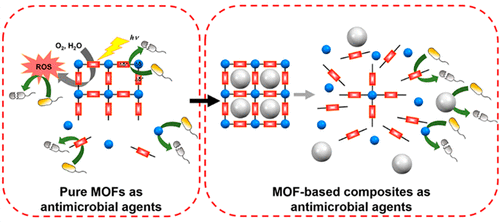Our official English website, www.x-mol.net, welcomes your feedback! (Note: you will need to create a separate account there.)
Metal–Organic-Framework-Based Materials for Antimicrobial Applications
ACS Nano ( IF 17.1 ) Pub Date : 2021-02-25 , DOI: 10.1021/acsnano.0c09617 Rui Li 1 , Tongtong Chen 1 , Xiangliang Pan 1
ACS Nano ( IF 17.1 ) Pub Date : 2021-02-25 , DOI: 10.1021/acsnano.0c09617 Rui Li 1 , Tongtong Chen 1 , Xiangliang Pan 1
Affiliation

|
To address the serious threat of bacterial infection to public health, great efforts have been devoted to the development of antimicrobial agents for inhibiting bacterial growth, preventing biofilm formation, and sterilization. Very recently, metal–organic frameworks (MOFs) have emerged as promising materials for various antimicrobial applications owing to their different functions including the controlled/stimulated decomposition of components with bactericidal activity, strong interactions with bacterial membranes, and formation of photogenerated reactive oxygen species (ROS) as well as high loading and sustained releasing capacities for other antimicrobial materials. This review focuses on recent advances in the design, synthesis, and antimicrobial applications of MOF-based materials, which are classified by their roles as component-releasing (metal ions, ligands, or both), photocatalytic, and chelation antimicrobial agents as well as carriers or/and synergistic antimicrobial agents of other functional materials (antibiotics, enzymes, metals/metal oxides, carbon materials, etc.). The constituents, fundamental antimicrobial mechanisms, and evaluation of antimicrobial activities of these materials are highlighted to present the design principles of efficient MOF-based antimicrobial materials. The prospects and challenges in this research field are proposed.
中文翻译:

金属-有机框架基材料,用于抗菌应用
为了解决细菌感染对公共卫生的严重威胁,已致力于开发抑制细菌生长,防止生物膜形成和灭菌的抗菌剂。最近,由于其不同的功能,包括控制/刺激的具有杀菌活性的成分的分解,与细菌膜的强相互作用以及光生活性氧的形成,金属有机骨架(MOF)已成为各种抗菌应用的有前途的材料( ROS)以及其他抗菌材料的高负载和持续释放能力。这篇评论的重点是基于MOF的材料在设计,合成和抗菌应用方面的最新进展,等)。重点介绍了这些材料的成分,基本的抗菌机制以及对抗菌活性的评估,以介绍有效的基于MOF的抗菌材料的设计原理。提出了该研究领域的前景和挑战。
更新日期:2021-03-23
中文翻译:

金属-有机框架基材料,用于抗菌应用
为了解决细菌感染对公共卫生的严重威胁,已致力于开发抑制细菌生长,防止生物膜形成和灭菌的抗菌剂。最近,由于其不同的功能,包括控制/刺激的具有杀菌活性的成分的分解,与细菌膜的强相互作用以及光生活性氧的形成,金属有机骨架(MOF)已成为各种抗菌应用的有前途的材料( ROS)以及其他抗菌材料的高负载和持续释放能力。这篇评论的重点是基于MOF的材料在设计,合成和抗菌应用方面的最新进展,等)。重点介绍了这些材料的成分,基本的抗菌机制以及对抗菌活性的评估,以介绍有效的基于MOF的抗菌材料的设计原理。提出了该研究领域的前景和挑战。



























 京公网安备 11010802027423号
京公网安备 11010802027423号